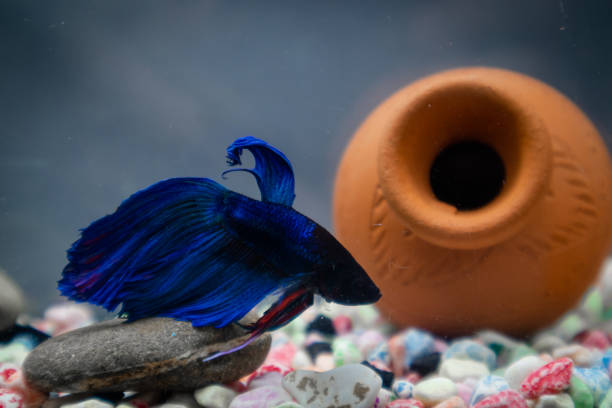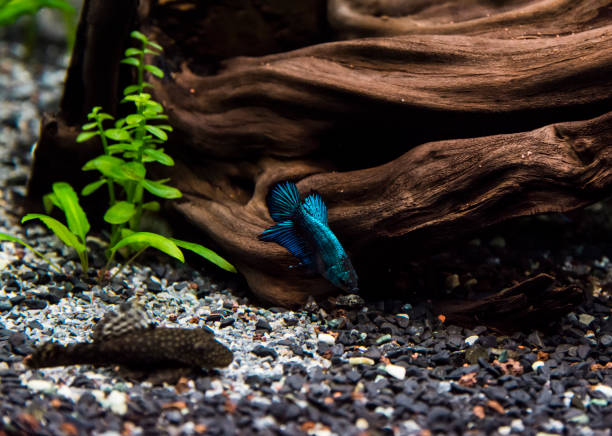Why Betta Fish Staying at Top of Tank: Causes and Prevention
Betta fish typically live in groups of around six and prefer to live in an environment with plenty of plants and floating objects to explore. Because bettas are so territorial, some aquarists choose to keep them in individual tanks or small groups, while others keep them in larger tanks with plenty of plants and other fish.
Bettas like to stay near the top of their tanks so they can get the best availability of oxygen. This is because they have a lot of energy and need to be active to keep their fins healthy. In addition to this, there are other reasons why your bettas may be staying at the top of your aquarium. Let’s find out these common causes.

Table of Contents
Reasons Why Bettas Stay At Top of Aquarium
Low Oxygen Concentrations
One of the most common reasons why bettas stay near the top of their tanks is because there are low oxygen concentrations. When oxygen levels get too low, your fish can start to experience problems including aggression and difficulty breathing. If you notice that your bettas are staying at the top of their tanks more often, it may be a good idea to increase the oxygen concentration in that area of your tank. Another way to help alleviate this stress is to add more plant ornaments to the tank. Additionally, adding a bubbling filter will help increase the level of dissolved oxygen in the water.
How to Deal With a Lack of Oxygenation?
If your betta fish is staying at the top of its tank, you can try adding a bubbling filter. This will allow it to get more oxygen than if there weren’t any plants up against the wall that could promote aeration and circulate water. If your betta fish is not getting enough oxygen, there are a few things you can do to help. First, make sure the water is clean and clear. If the water has a lot of debris or algae in it, it will be hard for the fish to breathe. Second, make sure the tank is well-lit and that there are plenty of areas for the fish to hide. Finally, provide plenty of high-quality food and oxygen supplements for your fish.
Temperature Problems
Another reason why bettas stay near the top of their tanks is that the temperature at the bottom of the tank is too cold. If your water has a low temperature, it can be hard for fish to maintain their body temperatures. When this happens, they will start to move up towards higher levels to stay warm. Additionally, if there are not enough areas in your tank for your fish to hide, they may try to move towards the top of their tanks to escape.
How to Prevent Temperature Problems?
To keep your betta’s temperature stable, make sure there are plenty of hiding areas in your tank and use a bubbling filter. Also, consider adding some floating plants or driftwood decorations into the tank as well. By doing these things you can help create more places for fish where they can feel comfortable and cool off if needed without making them stay too high up.
Unstable Water Parameters
Betta fish are tropical fish that require warm water with a pH of 6.5-8 and a temperature of 75-81 degrees Fahrenheit (23.8-27.2 degrees Celsius). If your water parameters are not meeting these standards, your betta may stay at the top of the tank due to stress or illness. Check your water parameters regularly and adjust them as needed to maintain the correct temperature and pH level for your betta.
Too Much Ammonia
If the ammonia level in your tank is too high, your betta may stay near the top of their tanks to escape the smell. Ammonia is a by-product of fish digestion and can cause water conditions to become dangerous for your betta. Try adding freshwater algae or invertebrates into the tank as an amendment to help decrease the amount of ammonia produced. If these solutions don’t work, you may need to get rid of the rotting matter in your tank and remove all chemicals that do not belong there.
How to Fix Ammonia Issues?
If your betta fish is exhibiting signs of ammonia toxicity, it’s important to take action as soon as possible. Here are a few tips on how to fix ammonia issues in your fish tank:
- Remove any uneaten food or debris from the aquarium and make sure that there is enough oxygen circulating throughout the tank. Ammonia gas is produced when organic material decomposes, so making sure there’s plenty of fresh water and good ventilation will help to reduce the amount of waste that can create ammonia levels in the tank.
- Change out half of your aquarium’s water every week to keep it clean and free of toxins. This will also help reduce the amount of ammonia produced by your fish.
- Add some bacterial algae cleanser to your tank every week to break down organic material and help to reduce the levels of ammonia.
- Use a fish carbon filter if there is blue-green algae growth in your tank or if you notice that the water has an unpleasant odor. The carbon will remove harmful toxins from the water while providing amenities such as oxygen and minerals for your betta fish.
Overcrowding
Many betta fish enthusiasts keep their pets in small tanks or groups, which can lead to overcrowding. Bettas are territorial animals and will defend their space aggressively if they feel threatened. If your tank is too small for the number of fish you have, you may find that your bettas choose to stay near the top where oxygen levels are higher.
How to Deal With an Overcrowded Tank?
It can be frustrating when you have a tank that is too full and your betta fish are struggling to find space to swim. There are a few things you can do to help your fish and tank stay healthy and happy in an overcrowded environment:
- Make sure the tank is large enough for your betta fish. The minimum size for a betta tank is 10 gallons, but 12 or even 16 gallons are better for most bettas. If the tank is too small, your fish will feel stressed and may start to exhibit negative behaviors such as hiding, eating their fins, or displaying aggressive behavior.
- Consider adding some live plants to the tank. Live plants provide cover and a place for your fish to hide, and they also provide food for them.
- Use a betta tank divider if you have more than one betta fish in the tank. This will allow each fish some space to swim and rest, without the risk of getting territorial over small areas of the tank.
Lack of Food
Many betta enthusiasts report that their fish will become thin and inactive if they don’t have access to food every day. A lack of food can also lead to negative behaviors such as staying afloat at the top of the aquarium, aggressive behavior, hiding, and even death in some cases. If your betta fish hasn’t been eating or appears weak, take a closer look at their tank conditions. If you’re noticing that your betta fish isn’t eating as much as usual, one possibility is that they are not getting the nutrients they need in their tank. Nutrients include food, vitamins, and minerals. If your fish aren’t getting enough of these important nutrients, their health may start to decline.
Swim Bladder Issues
A swim bladder is a gas-filled organ located just above your betta fish’s stomach and intestines. This organ helps control their buoyancy in water, and problems with it can lead to swimming difficulties, especially if the fish is kept in an overcrowded tank. If you notice that your betta fish isn’t floating as easily as usual or they aren’t diving into the water like they used to, take them for a checkup at a fish vet to rule out a swim bladder issue.

How to Keep Your Bettas From Swimming at the Top?
Betta fish are often kept in aquariums with other fish. When the betta fish feels threatened or is not happy, it may swim to the top of the tank. This can be frustrating for owners as it means that their betta fish is not content and may need to be moved to a new home. There are ways to keep your betta from swimming at the top of the tank and keeping them happy in their new home.
Elevate Oxygen Concentrations
Betta fish are obligate air breathers and require high levels of oxygen to survive. When the water level in a tank drops, the oxygen levels in the water decrease as well. This can lead to health problems for your Betta fish, including stunted growth and even death. To prevent these problems, it is important to keep the water level high and maintain consistent oxygen concentrations.
Adjust the Temperature
Betta fish are tropical fish and as such, they like warm water temperatures. Some people keep betta fish in tanks that have a temperature of around 75 degrees Fahrenheit, while others set the tank’s temperature to 81 degrees Fahrenheit.
Maintain High Water Quality
Betta fish are tropical fish that thrive in warm, clear water with a moderate to a high level of dissolved oxygen. However, maintaining high water quality is essential for these fish. Improper water quality can lead to disease, stunted growth, and even death in bettas. To keep your betta healthy and thriving, keep your tank clean, use a good filter, and maintain a moderate level of dissolved oxygen.
Get the Right Tank Size
When you’re choosing the right tank size for your betta fish, it’s important to consider their natural habitat and how big they will grow. Betta fish naturally live in small groups in slow-moving water with plenty of plants and hiding places. A tank that is too small will not provide enough space for them to swim around and explore, while a tank that is too large can be stressful for them and lead to territorial behavior. A good rule of thumb is to give your betta fish at least two times its body length (in inches) as their aquarium size, but make sure to check with your local fish store or pet retailer for specific recommendations.
Provide Hiding Places
Betta fish are often kept in tanks with other fish. One way to ensure your betta fish is safe and secure is to provide it with hiding places. This will help keep it from being harassed by other fish or from feeling insecure in its surroundings. Some good hiding places for betta fish include caves, rocks, and even small plants.
Healthy Diet
Betta fish are active and playful fish that need a good diet to stay healthy. They should be fed a variety of live and frozen food, including blood worms, mosquito larvae, brine shrimp, and daphnia.